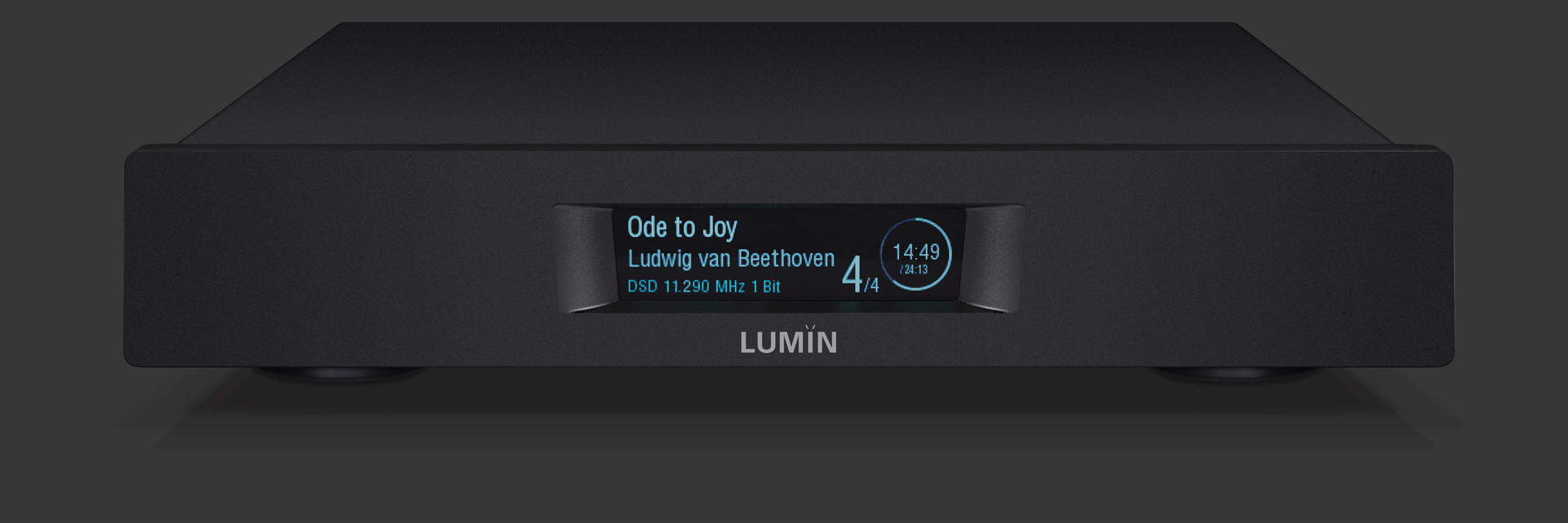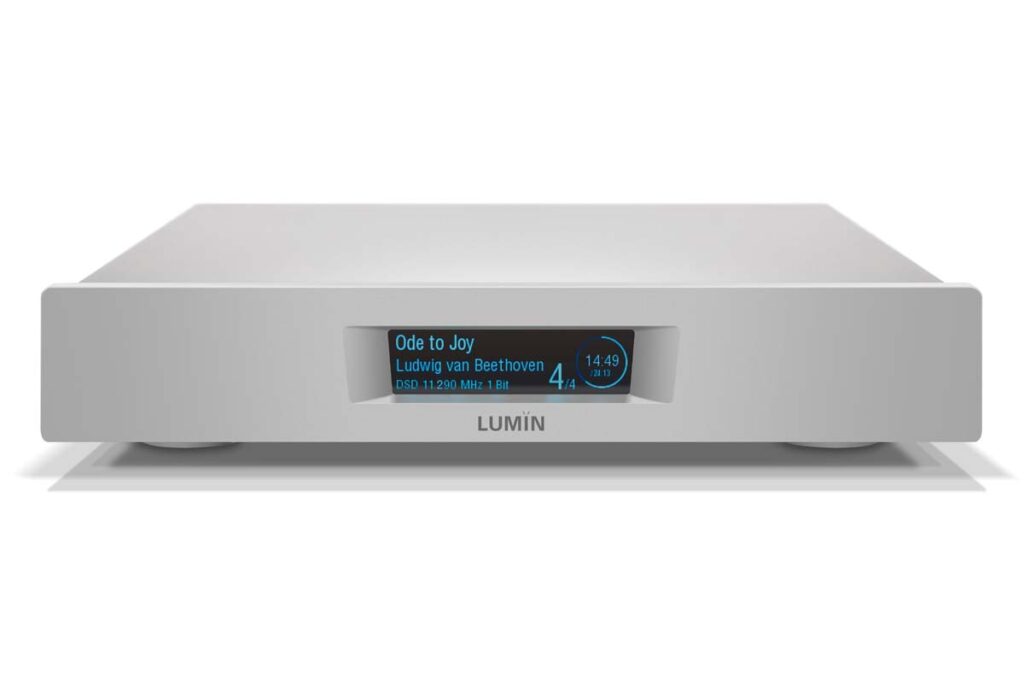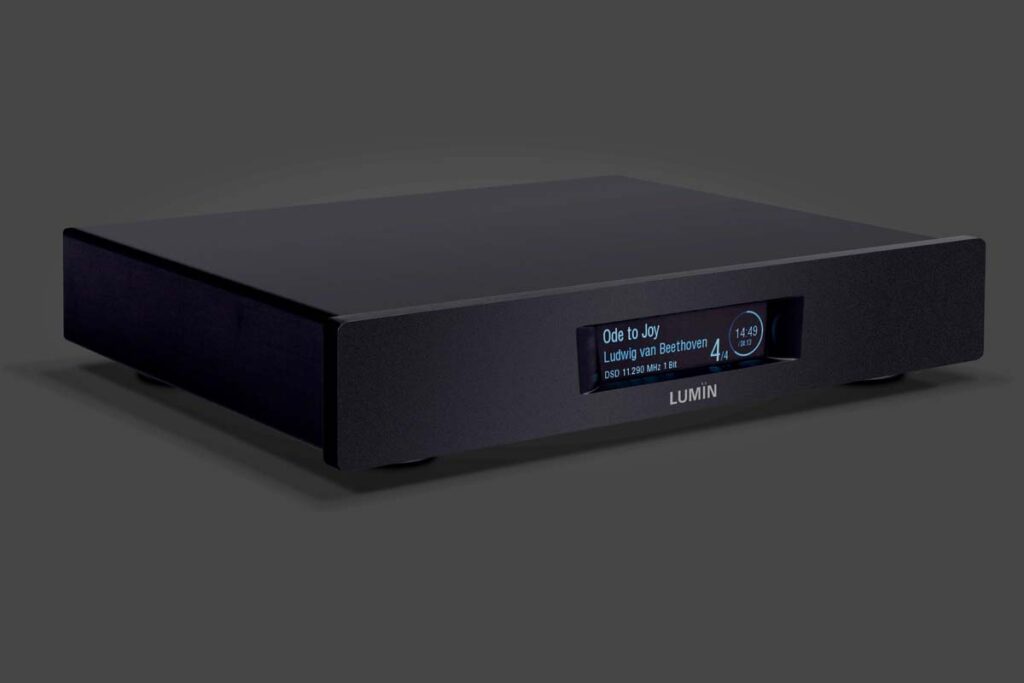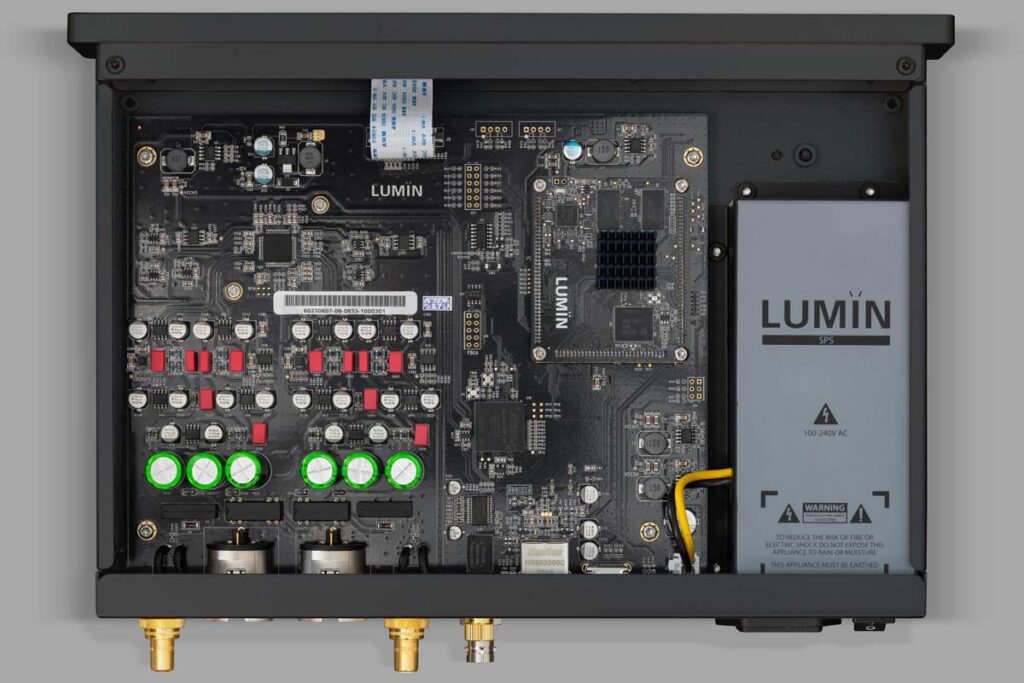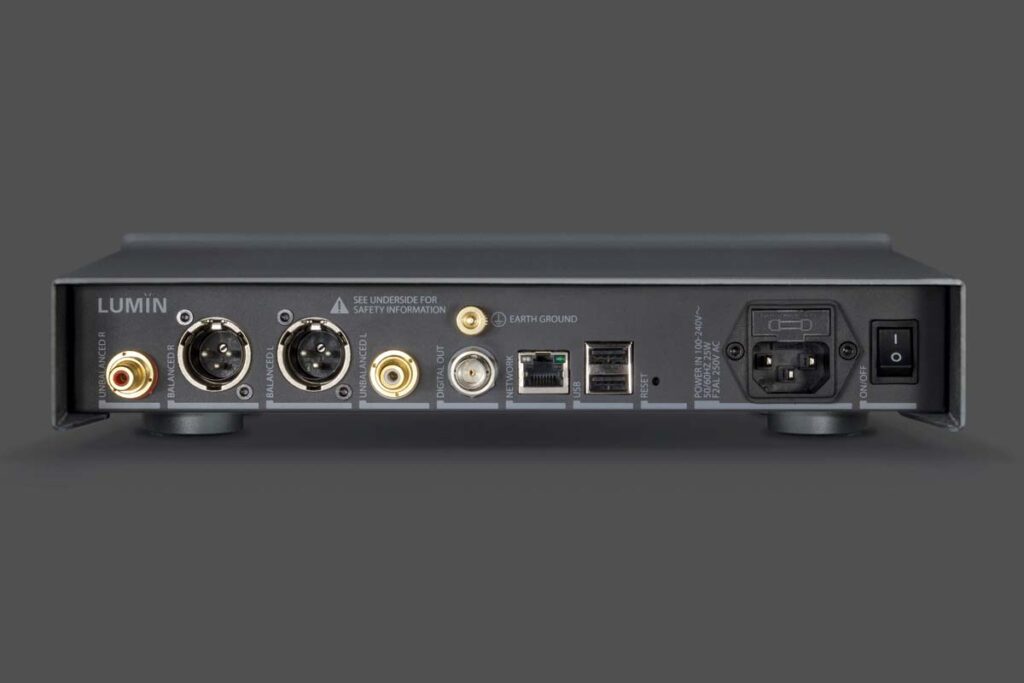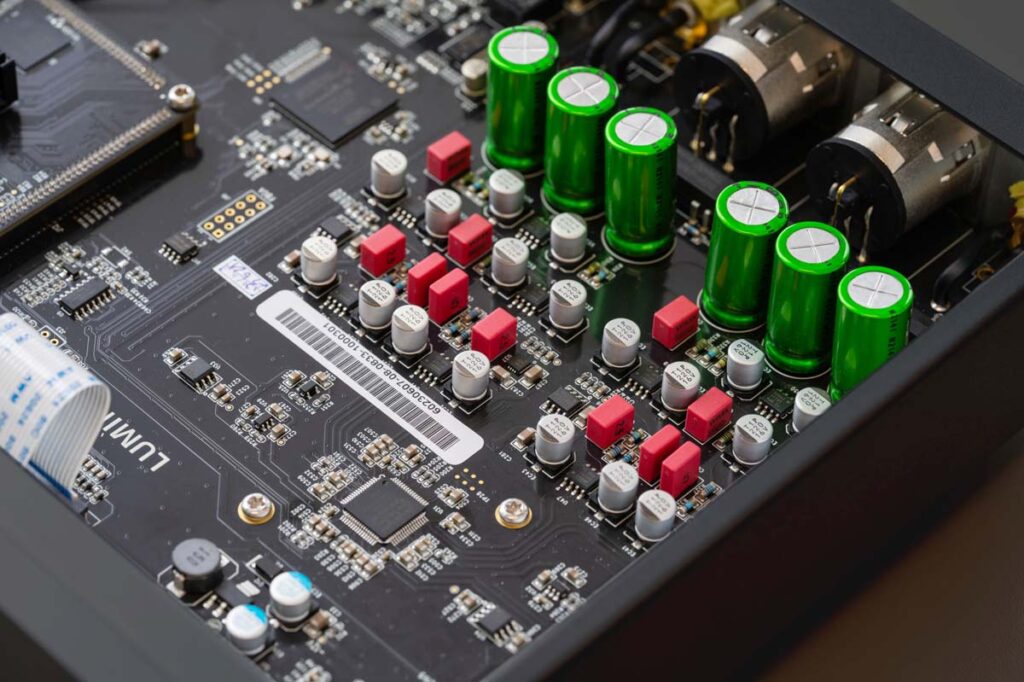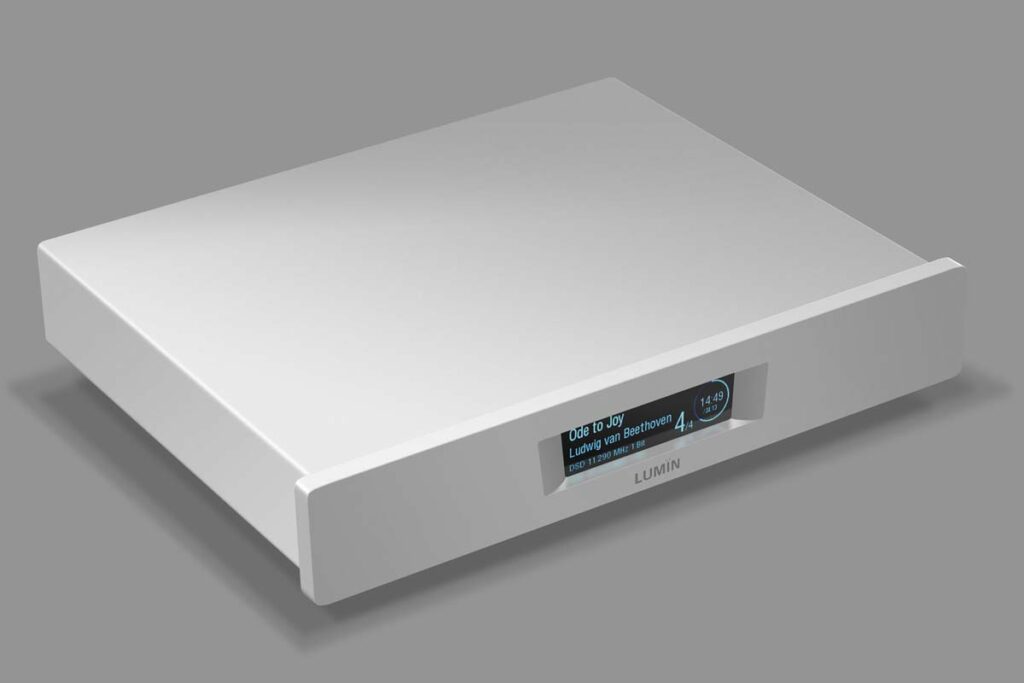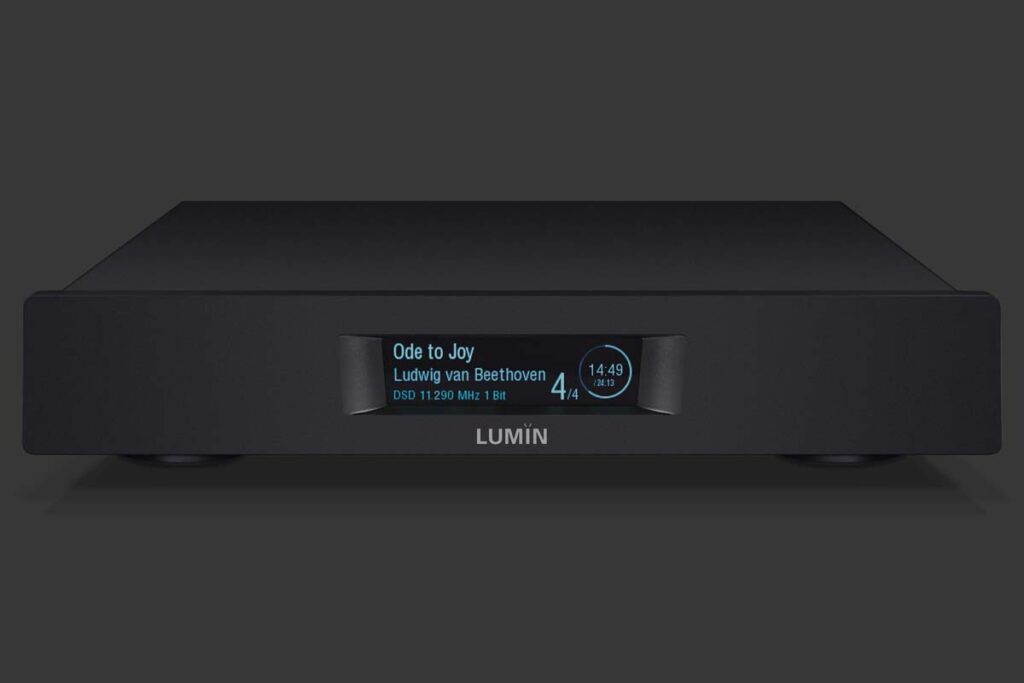The D3 is the entry point into the family of combined streamers/DACs from Lumin. In terms of sound quality, the “little one” has set its sights on the upper league.
Anyone who isn’t just looking for technology and sound quality in the streaming part of their system, but also values good design, provenance and a certain style, will inevitably end up with Lumin. The digital specialist from Hong Kong tailors the most elegant aluminum enclosures for its D/A converters and streamers. The flat housings with the clean arc at the front front and the central display slot are absolutely unmistakable and, as they are milled from a solid block of aluminum, convey immense value. A shame, then that Lumin has cut the odd corner with it’s D3, the smallest of its three streamers/DACs. But it’s better to save on the housing than on the technology. And even so, this entry-level Lumin has still come out stylish.
The now lightweight and cuboid aluminum casing contains a technical core that is surprisingly similar to that of the larger models. A brief classification: The D3 is part of a family of three. The other members bear the names T3 and X1 and price tags of around twice and five times the 2590 euros that the D3 will set you back. There’s also the P1, which, positioned between the T3 and X1 in terms of price, stands out despite the similarities; analog inputs and HDMI interfaces make it a fully-fledged preamp. And it also has a digital input (USB), but more on this in a moment.
The generation change from the predecessor D2 to the D3 also means a change of DAC type. While the D2 still used Wolfson chips, the D3 features a Sabre ES9028PRO from Californian specialist ESS. The same DAC also does conversion duty in the larger Lumin T3, albeit as a pair. The top model X1 is adorned with the “big” ESS DAC ES9038PRO, also in a twin pack.
Looking under the lid, even the layman can see how Lumin has scaled up the concept. Just like the T3 and X1, the D3 carries all analog and digital components on a main board that takes up three quarters of the housing (the fourth quarter is reserved for the switching power supply). The audio signal path is fully balanced. A small extra board for streaming sits piggybacked on the mainboard. It is identical to the one in the T3, which is twice as expensive. The new development with more computing power is intended to make the streamer fit for demanding software updates and new functions.
On the front of the D3, the same narrow display shines its teal light into the listening room as on all other Lumin streamers. In addition to information about the current track, a circular segment shows the remaining playing time. I will miss this clever feature when my completely displayless Innuos takes over streaming again. There is, however, one small design flaw.
The lid of the D3 protrudes beyond the connection panel, effectively concealing the tangle of wires behind it. That’s a good thing! On the X1, which I had the pleasure of using in 2020, a clever developer rotated the balanced XLR connections by 180 degrees so that the locking mechanism, which is usually at the top, was facing downwards, making it accessible for adult hands. However, this was not possible with the D3 due to the layout of the circuit board. Let me put it this way: Obsessive cable comparers will have more fun with their hobby using the RCA connections.
The D3 offers neither WiFi nor Bluetooth and must be integrated into the network by cable. For optional external conversion, the digital music signal is provided via BNC socket, the D3 then acts purely as a bridge. Anyone expecting that there should consequently also be a digital input to give, say, a CD player access to the fine DAC, will be disappointed. The two USB-A sockets can only used to connect storage media.
It streams, it converts – and it can drive a power amplifier directly. The analog output signal of the D3 can be attenuated, and not just by any means, but digitally with the help of “Leedh Processing” algorithms. The technology behind this is based on the work of Swiss developers who decided to eliminate the inevitable loss of information from digital volume control. Judging by the illustrious high-end brands that have implemented Leedh Processing in their devices, some of which are priced in the five-digit range, the goal has been achieved. The volume cannot be adjusted on the device. However, this wasn’t a problem for us, as we controlled the streamer via the excellent Lumin app anyway. If desired, the manufacturer also offers an optional IR remote control.
The manufacturer must be praised unreservedly for the app: it is clearly laid out, runs stable and plays a large part in the amazing longevity of the streamers. It also gives you access to a real highlight: the diverse resampling options. Why resampling and not upsampling? Because the Lumin can do both. Upsampling for a sonically advantageous supply of HD converters is widely known. Downsampling high-resolution material can be useful for compatibility with older DACs. Either way, this is a playground where you can work out the optimum parameters for your favorite music to your heart’s content. The app natively supports all major streaming services, including the new HD providers. The software developer responsible, Peter Lie, is active on numerous forums, diligently answers questions and accepts suggestions from the user community. As a long-time Roon user, I have operated the D3 via this interface, which I like better than the playlist-based Lumin app. Until recently, this would have been purely a matter of taste. But with Generation 3, Lumin introduced a small plus point for Roon users: “Roon Exclusive Mode” (which you have to activate via the app) disables unnecessary system services while at the same time improving sound performance.
The D3 is a streamer/DAC, which is how I integrated it into my system. My Silvercore Pre took over the preamplification because I don’t like software controls. The wiring was balanced. The Qobuz access data was entered in no time at all, the contact to the Roon-Core Innuos Zenith Mk III was established – and off we went!
The little Lumin has power. Its sound is immediately engaging, it is rhythmically on point, rich in color, contoured and has substance. Where the spontaneous reaction of other digital players was to conjure up “breathing” rooms or holographically traced stages, the small Lumin’s physical, dense presentation is captivating and fun from the very first note. This doesn’t mean that it lacks atmosphere or resolution – it just doesn’t focus on either. The D3 could certainly be said to have a particularly pleasant, holistic approach to the treble.
In a direct comparison with my Aqua La Voce S3 D/A converter, the Lumin wins with precisely this punch. This is actually a fairly big deal. After all, with the Italian DAC, we are dealing with an elaborately built R2R converter, supplied by two linear power supplies based on toroidal transformers, whereas the Lumin is connected to a switching power supply. Well, after intensive listening, the Aqua can win back its ground with its very own elegance and openness. But the D3 remains the more fun machine. I suspect that the sonic performance is mainly down to the new ESS converter. And indeed, nothing changes in the differences in character between the two devices when the Aqua is connected directly to the Lumin via the finest BNC cable. This makes the absence of a digital input on the D3 all the more painful.
In another system, the Lumin is given the opportunity to prove itself as an upgrade for ambitious audiophiles. Here it is accompanied by an Innuos Zen Mini, with a Naim DAC-V1 from 2013 acting as the converter. After ten minutes of warm-up time, the result is clear. Once again, it is the colors, the intensity and the pressure with which the Lumin shows the beautiful but aging Naim what’s what these days. However, the owner of the latter wouldn’t want to view the more laid-back sound of his beloved converter as objective sonic inferiority. Which could lead us to an exciting side topic: Sound signatures of DAC chips and the question of whether there can be one converter for everyone or whether you have to choose one way after all. My money is on the latter.
With its streamer, DAC and lossless volume control, Lumin’s D3 combines three components at the highest level in its inconspicuous housing. Purists connect a pair of active speakers and get a system that can give heavyweights a run for their money. Sensible John Does take the opportunity to reduce their number of devices and replace the converter and streamer with a combined component that is unlikely to be bested by separates in the foreseeable future, even for a hefty surcharge. The latest version of Lumin’s entry-level range is a banger!
Accompanying Equipment
Turntable: bauer audio dps 3 | Tonearm: bauer audio Tonarm | Cartridge: Lyra Kleos | Phono preamplifier: Hagerman Trumpet Wood | Step-up transformer: Consolidated Audio Silver/Nano | CD player: Electrocompaniet EMC 1 UP | Music server: Innuos Zenith Mk III | D/A converter: Aqua La Voce S3 | Switch: Silent Angel Bonn N8 | Preamplifier: Silvercore linestage two | Power amplifier: Rowland Model 2 | Speakers: Ayon Seagull/c | Power conditioning: AudioQuest Niagara 3000 | Cables: Fadel Art, Ansuz, Phonosophie, Sun Audio, AudioQuest, Solidcore | Accessories: Creaktiv racks, granite bases
Network player Lumin D3
Concept: fully balanced streamer and D/A converter with digital volume control | Inputs: Ethernet RJ45, 2 x USB A (for mass storage) | Digital outputs: S/PDIF (BNC) | Analog outputs: XLR balanced, RCA unbalanced | Finishes: Black, silver | Accessories: IR Remote Kit (optional, around € 299) | Dimensions (W/H/D): 30/6/25 cm | Weight: 2.5 kg | Warranty period: 3 years | Price: around € 2590
IAD
Johann-Georg-Halske-Straße 11
41352 Korschenbroich
Phone +49 2161 617830

